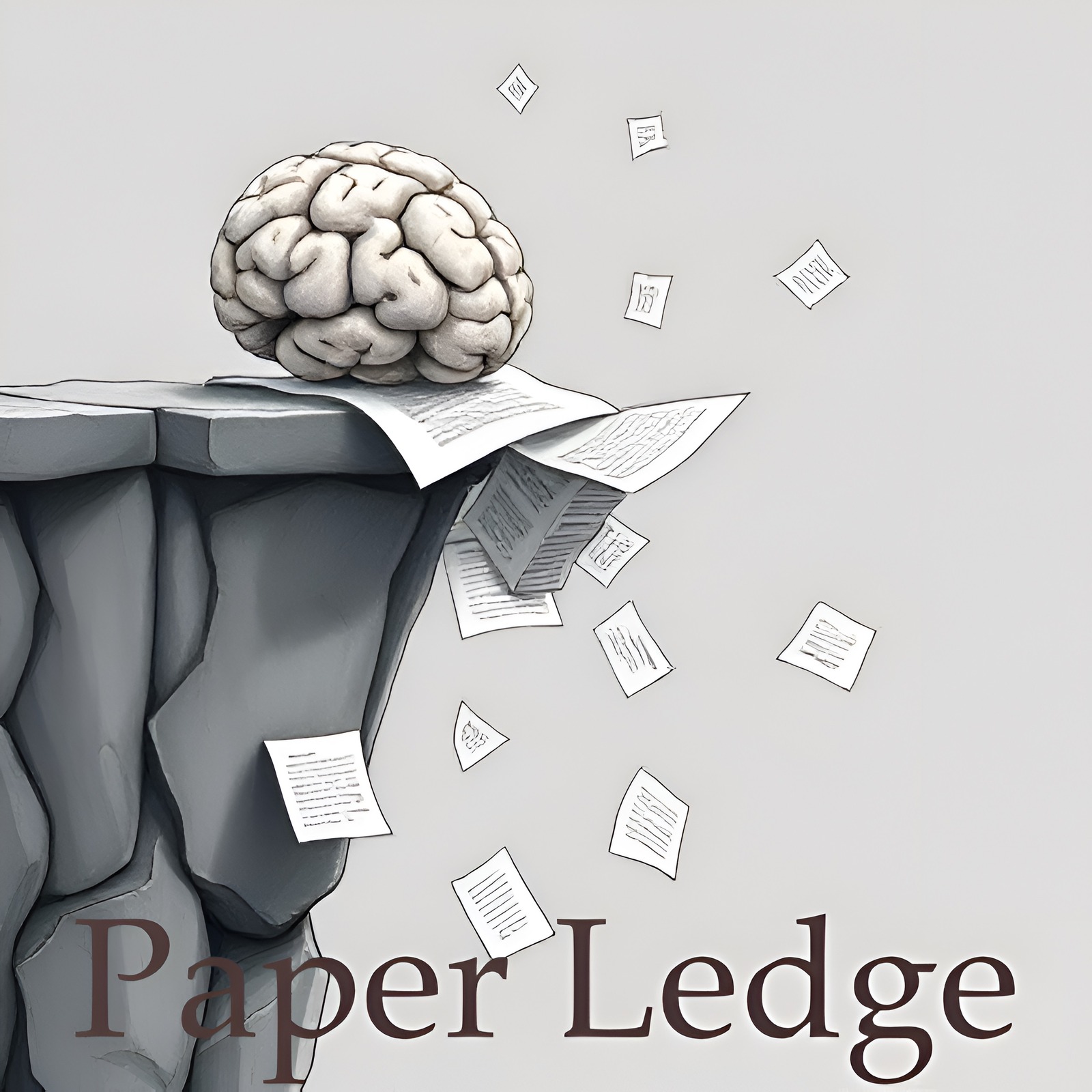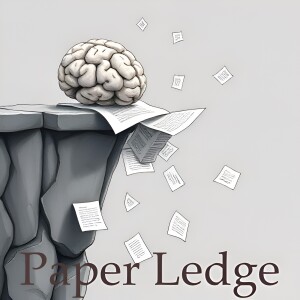PaperLedge

PaperLedge where research meets storytelling is a revolutionary podcast where cutting-edge research meets AI-powered storytelling. Hosted by the Ernis, whose blend of gentle reassurance, cosmic wonder, explanatory clarity, and enthusiastic charm makes complex research accessible to everyone. Each episode, Ernis transforms the latest academic papers into engaging, jargon-free audio experiences that deliver key insights in digestible formats. Whether you’re a researcher seeking interdisciplinary perspectives, a student supplementing your studies, or simply curious about scientific breakthroughs, PaperLedge has something for you.
Episodes
Episodes



Friday Nov 07, 2025
Computer Vision - Tracking and Understanding Object Transformations
Friday Nov 07, 2025
Friday Nov 07, 2025
Hey Learning Crew, Ernis here, ready to dive into some fascinating research that's all about how computers can see the world changing around them – kind of like how we do!
Today, we’re talking about a new paper tackling a tricky problem: tracking objects as they transform. Think about it – an apple starts whole, then gets sliced. A caterpillar goes into a cocoon and emerges as a butterfly. These are all transformations, and while we humans can easily follow what's happening, it's much harder for a computer.
The existing methods often fail because they get confused when the object's appearance changes drastically. It's like trying to recognize your friend after a complete makeover – the computer just doesn't know it's the same thing anymore!
That’s where this new research comes in. The authors introduce something called "Track Any State." It's all about tracking objects through these transformations and even figuring out what kind of changes are happening. They've even created a new dataset, VOST-TAS, to test this!
Now, the cool part is how they solve this. They've developed a system called TubeletGraph. Imagine a detective trying to solve a mystery. This system is like that detective, using clues to find "missing" objects after they've transformed.
Here's how it works in a simplified way:
First, it looks for any tracks that might have been missed – any potential "suspects" that disappeared.
Then, it decides whether these missing tracks are actually connected to the object being tracked, based on things like:
What the object is (its "semantic" meaning – is it a fruit, an animal, etc.?)
How close it is to the original object (its "proximity")
Finally, it puts all the pieces together and creates a "state graph." This graph shows how the object's states evolve over time – like a timeline of the transformation.
Think of it like following a recipe. TubeletGraph needs to understand all the steps (transformations) that change the ingredients (objects). It’s not enough to just see the start and end result; it needs to understand the process.
The results are impressive! TubeletGraph is apparently really good at tracking objects through transformations. But more than that, it shows a deeper understanding of what's actually happening during these changes. It can even reason about time and meaning, which is a big step forward.
"TubeletGraph achieves state-of-the-art tracking performance under transformations, while demonstrating deeper understanding of object transformations and promising capabilities in temporal grounding and semantic reasoning for complex object transformations."
Why does this matter? Well, think about:
Self-driving cars: They need to understand when a pedestrian steps behind a tree (a transformation of sorts) and emerges on the other side.
Robotics: Imagine a robot assembling furniture. It needs to track the parts as they're combined and transformed into the final product.
Video analysis: Being able to understand and track transformations in videos could unlock all sorts of insights, from medical imaging to sports analysis.
So, Learning Crew, a few questions that popped into my head while digging into this:
Could this technology eventually be used to predict future transformations? Like, could it anticipate how a piece of fruit will decay over time?
How well does TubeletGraph handle transformations that are unexpected or unusual? What happens when the apple is not just sliced, but also blended?
What are the ethical implications of having machines that can track and understand transformations so well? Could it be used for surveillance or other purposes we might not be comfortable with?
Definitely some food for thought! The research is available at https://tubelet-graph.github.io if you want to get into the nitty-gritty. Until next time, keep those learning gears turning!Credit to Paper authors: Yihong Sun, Xinyu Yang, Jennifer J. Sun, Bharath Hariharan



Thursday Nov 06, 2025
Thursday Nov 06, 2025
Alright learning crew, Ernis here, ready to dive into some fascinating research hot off the press! Today, we're talking about making AI smarter and faster, specifically when it comes to reasoning. Think of it like this: imagine you're teaching a kid how to solve a math problem. You might start by having them write out every single step. That's like how current AI, called Large Language Models (LLMs), often solve problems – using what's called "Chain-of-Thought" or CoT prompting.
CoT prompting is basically showing the AI exactly how to think through a problem, step by step. It's like giving it a detailed recipe. This helps them get more accurate answers. But, just like writing out every step in a math problem takes time and paper, all that "thinking out loud" makes the AI slower and uses more computing power.
Now, a lot of the work being done right now focuses on making those step-by-step explanations shorter. It's like summarizing the recipe after you've already made the dish a few times. That helps, but the AI is still relying on that explicit reasoning, that detailed recipe, even if it's a condensed version.
That's where this new paper comes in! These researchers have come up with something called 3TF, which stands for Thought-Training and Thought-Free inference. It's a game-changer because it flips the script. Instead of going from a long, detailed explanation to a shorter one (Long-to-Short), they're going from a short output to, essentially, a long, internal thought process (Short-to-Long).
Think of it like learning to ride a bike. At first, you're consciously thinking about every single movement – balancing, pedaling, steering. You're writing out the steps in your head, so to speak. But eventually, you just do it. You don't need to think about each step anymore; it becomes automatic. That's what 3TF is trying to achieve with AI.
Here's how it works:
First, they train a special AI model that can work in two ways: one where it shows its work, and one where it just gives the answer.
Then, they train it using data where the answers do have those step-by-step explanations (CoT-annotated data). This helps the AI learn how to reason properly.
But, the key is that when the AI is actually solving problems, it uses the mode where it doesn't show its work. It's like the AI is reasoning internally, but only giving you the final answer.
In essence, 3TF allows the AI to learn how to reason deeply without needing to explicitly write out every single step. It's like having a super-smart AI that can solve complex problems in its head and just give you the answer – much faster and more efficiently!
"3TF improves the reasoning quality of non-reasoning outputs, enabling models to perform rich internal reasoning implicitly while keeping external outputs short."
The results? The researchers found that AI models trained with 3TF were much better at reasoning, even when they weren't showing their work. This means they learned to reason implicitly, without needing to generate those long, step-by-step explanations. It's a big step forward in making AI more efficient and powerful.
So, why does this matter?
For researchers, it opens up new avenues for developing more efficient and powerful AI models.
For developers, it means creating AI applications that are faster and use less computing power.
And for everyone else, it means a future where AI can solve complex problems more quickly and efficiently, leading to advancements in fields like medicine, engineering, and more!
This research really gets the brain buzzing, right? I'm left wondering:
Could this approach be applied to other areas of AI, like image recognition or natural language understanding?
How can we ensure that the internal reasoning process of these AI models is still transparent and accountable, even if we can't see the steps?
Food for thought, learning crew! I'm excited to see where this research leads us. Until next time, keep learning and keep questioning!Credit to Paper authors: Canhui Wu, Qiong Cao, Chao Xue, Wei Xi, Xiaodong He



Thursday Nov 06, 2025
Thursday Nov 06, 2025
Alright learning crew, Ernis here, ready to dive into some fascinating tech! Today, we're talking about something that probably affects all of us, whether we realize it or not: software. Think of software like the engine in your car. It needs regular maintenance and upgrades to run smoothly and efficiently. That's where refactoring comes in – it’s like giving your software engine a tune-up. It's about improving the internal structure of the code without changing what it does.
Now, usually, refactoring is something skilled developers handle, often spending hours poring over lines of code. But what if we could automate some of that process? That's where Large Language Models, or LLMs, come into play. You've probably heard of these – they're the brains behind many AI tools these days. They can understand and generate human-like text, and now, they're being used to help with software refactoring.
This paper explores using LLMs, not just as simple instruction followers, but as intelligent agents working together as a team, like a pit crew for your software. Imagine each agent has a specific role: one plans the refactoring, another executes it, a third tests it, and a final agent reflects on the whole process and suggests improvements. This team is called RefAgent.
The researchers put RefAgent to the test on eight different open-source Java projects. They compared it against a single LLM agent trying to do everything, a traditional search-based tool, and even how actual developers had refactored the code in the past. They looked at three key things:
Code Quality: Did the refactoring improve the software's overall quality? Think cleaner code, fewer bugs, and better performance.
Opportunity Recognition: Could RefAgent identify areas in the code that needed refactoring? It's like spotting a worn-out part in your car engine.
Agent Contribution: How much did each agent contribute to the overall success? This helps understand which roles are most important.
So, what did they find? Well, RefAgent did pretty darn well! It achieved a 90% success rate on unit tests, meaning the refactored code was robust and didn't break existing functionality. It also reduced "code smells" by over 50%. "Code smells," by the way, are like little hints that something might be wrong with the code – think of them as the software equivalent of that funny noise your car makes sometimes.
"RefAgent improves the median unit test pass rate by 64.7% and the median compilation success rate by 40.1% compared to single-agent approaches."
RefAgent also identified refactoring opportunities at a rate similar to human developers and the search-based tool. And, crucially, it outperformed the single-agent approach by a significant margin. This shows the power of having a team of specialized agents working together.
So, why does this matter to you, the listener?
For Developers: This research suggests a potential future where refactoring is less tedious and more automated, freeing up your time for more creative problem-solving.
For Project Managers: Automated refactoring can lead to higher quality software, reduced development costs, and faster release cycles.
For Everyone Else: Better software means a better user experience, fewer bugs, and more reliable technology in our daily lives.
This research highlights the potential of multi-agent LLM systems to transform software development. It shows that by breaking down complex tasks into smaller, more manageable roles, we can leverage the power of AI to improve the quality and efficiency of our software.
Here are a couple of things that really got me thinking:
How far away are we from a truly "self-healing" software system, where AI can automatically detect and fix problems without human intervention?
Could this multi-agent approach be applied to other complex tasks beyond software refactoring, like scientific research or financial analysis?
Food for thought, right? Let me know what you think in the comments below!Credit to Paper authors: Khouloud Oueslati, Maxime Lamothe, Foutse Khomh



Thursday Nov 06, 2025
Thursday Nov 06, 2025
Hey PaperLedge crew, Ernis here, ready to dive into some fascinating research! Today, we're tackling the unsung hero behind those awesome Large Language Models, or LLMs, that are powering everything from chatbots to creative writing tools: the tokenizer.
Now, you might be thinking, "Tokenizer? Sounds kinda boring." But trust me, it's anything but! Think of a tokenizer as the LLM's personal chef. It takes raw ingredients – words, sentences, even code – and chops them up into bite-sized pieces the LLM can actually digest. These "bite-sized pieces" are called tokens.
Why is this important? Well, the better the tokenizer, the better the LLM performs. A good tokenizer speeds up training, makes the LLM more efficient, and even reduces the cost of using it. It’s like having a chef that knows exactly how to prep food for maximum flavor and nutrition!
This paper focuses on tokenizers specifically designed for multilingual LLMs, and even more specifically, LLMs dealing with Indian languages. This is a big challenge! Indian languages are incredibly diverse, with different scripts and complex word structures. Existing tokenization methods, like Byte Pair Encoding (BPE), which is pretty standard, don't always cut it when dealing with this linguistic richness.
Imagine trying to use a single set of cooking utensils to prepare both sushi and lasagna. You could do it, but you’d probably get better results with specialized tools, right?
That's where IndicSuperTokenizer comes in. This isn't your run-of-the-mill tokenizer. It's a souped-up, custom-built tool that combines different tokenization techniques – subword and multi-word tokenization – with language-specific pre-processing. It’s like a chef who understands the nuances of every spice and ingredient!
The researchers found that IndicSuperTokenizer creates tokens that are more aligned with the actual meaning of the words, leading to some impressive results. How impressive? Well...
They measured something called a "fertility score," which basically tells you how well the tokenizer breaks down words into meaningful parts. IndicSuperTokenizer improved the average fertility score by a whopping 39.5% compared to LLaMA4, and by 18% compared to another top-performing tokenizer called Sutra!
This translates to a 44% improvement in how quickly the LLM can process information (inference throughput) compared to LLaMA4, while maintaining comparable performance on various language benchmarks.
"This isn't just about making things faster; it's about making things smarter."
They didn't just stop there. The researchers also did a bunch of experiments to test how different aspects of IndicSuperTokenizer affected its performance, things like:
How much training data they used
The size of the vocabulary
Different ways of merging tokens
Various pre-processing strategies
All this meticulous testing shows that their design choices were really solid and well-thought-out.
Why should you care?
For developers: This research provides a blueprint for building more efficient and accurate multilingual LLMs.
For users: Better tokenizers mean better translation, more natural-sounding chatbots, and more accurate information retrieval.
For language enthusiasts: This work highlights the importance of understanding linguistic diversity when building AI systems.
This paper raises some interesting questions, like:
Could this approach be adapted for other language families beyond Indic languages?
How does IndicSuperTokenizer handle truly rare or unseen words? Is there a fallback mechanism?
What are the ethical implications of using highly specialized tokenizers? Could it inadvertently introduce bias if not carefully managed?
That's all for today's dive into the world of tokenizers! I hope you found it insightful. Until next time, keep learning!Credit to Paper authors: Souvik Rana, Arul Menezes, Ashish Kulkarni, Chandra Khatri, Shubham Agarwal



Thursday Nov 06, 2025
Thursday Nov 06, 2025
Hey learning crew, Ernis here, ready to dive into another fascinating paper! Today, we're tackling something that's super important in the world of AI: getting those clever algorithms to work well in lots of different situations, not just the ones they were specifically trained for.
Think of it like this: imagine you train a dog to fetch a ball in your backyard. It's great at that, right? But what happens when you take it to a park with distractions, different sized balls, or even frisbees? It might get confused. That's kind of the problem we're facing with Graph Neural Networks, or GNNs. They're amazing at specific tasks, but struggle to adapt when things change.
GNNs are basically AI systems designed to understand and work with data structured like networks or graphs. Think of social networks, molecules, or even road maps. Each of these has nodes (people, atoms, cities) and edges (relationships, bonds, roads) connecting them. GNNs are great at analyzing these complex relationships.
Now, the paper we're looking at today highlights a big challenge: GNNs often aren't very good at generalizing. They might excel at predicting protein interactions, but then totally bomb when trying to analyze social networks. This is called negative transfer, where learning one thing actually makes you worse at something else. It's like learning to ride a bike and then suddenly forgetting how to walk!
And that’s not all. Retraining these models for each new task is super expensive in terms of time and computing power. It's like having to build a brand new car engine every time you want to drive on a different type of road!
So, what's the solution? Well, the researchers behind this paper propose something called GMoPE (Graph Mixture of Prompt-Experts). It's a mouthful, I know, but the idea is actually pretty clever.
Imagine you have a team of experts, each specializing in a different area – one's a social media guru, another’s a master chemist, and a third is an expert on transportation networks. GMoPE creates something similar within the GNN. It uses a "Mixture-of-Experts" approach, where different "experts" within the GNN specialize in different types of graph data.
But here’s the cool part: GMoPE uses something called "prompt-based learning". Think of a prompt as a little nudge or hint that helps the experts focus on the relevant information for a specific task. It's like giving each expert a different set of instructions tailored to the problem at hand.
The researchers also added a clever trick to prevent the experts from all trying to do the same thing. They encourage them to be different, to specialize in unique areas. This is done through a soft orthogonality constraint, which basically means they gently push the experts to be independent from each other.
"GMoPE consistently outperforms state-of-the-art baselines and achieves performance comparable to full parameter fine-tuning-while requiring only a fraction of the adaptation overhead."
And the best part? Instead of retraining the entire GNN for each new task, GMoPE only needs to adjust these "prompts." This is much faster and cheaper, like just changing the tires on a car instead of rebuilding the whole engine.
The researchers tested GMoPE on various tasks and found that it consistently outperformed other methods. It was even as good as retraining the entire model, but with way less effort!
So, why does this all matter?
For researchers: GMoPE offers a promising framework for building more generalizable and efficient graph AI models.
For industry professionals: This could lead to faster and cheaper deployment of GNNs in various applications, from drug discovery to social network analysis.
For everyone else: It means AI can become more adaptable and useful in solving real-world problems across diverse domains.
This research takes us one step closer to creating AI that can truly learn and adapt, making it more versatile and impactful.
Here are a few things I'm pondering after reading this paper:
How can we further improve the "routing" mechanism in GMoPE to ensure that the right experts are always activated for the right tasks?
Could this "mixture of experts" approach be applied to other types of AI models besides GNNs?
What are the potential ethical implications of having AI systems that can adapt so readily to new situations?
Let me know your thoughts, learning crew! What did you find most interesting about this research? And what questions does it raise for you?Credit to Paper authors: Zhibin Wang, Zhixing Zhang, Shuqi Wang, Xuanting Xie, Zhao Kang



Thursday Nov 06, 2025
Thursday Nov 06, 2025
Alright learning crew, Ernis here, ready to dive into something super cool: a new toolkit designed to make building software development agents way easier. Now, I know what you might be thinking: “Software agents? Sounds complicated!” And you’re not wrong, it can be. But stick with me, because this has the potential to change how we build software.
Think of it this way: imagine you have a team of tiny, tireless assistants dedicated to helping you code. These assistants can write code, test it, and even suggest improvements. That’s essentially what software agents are – little programs designed to automate tasks in the software development process.
But here's the thing: building these agents has traditionally been a real headache. It's like trying to build a Lego castle without instructions or the right pieces. That's where the OpenHands Software Agent SDK comes in. It's a toolkit, a box of all the right Lego bricks, complete with clear instructions, to make the whole process much smoother. Think of it as a "Software Agent Construction Kit."
This isn't just some minor update; it's a complete overhaul of the agent components from the popular OpenHands framework, which, by the way, already has over 64,000 stars on GitHub – that’s like the rockstar of software development tools!
So, what makes this SDK so special? Let's break it down:
Flexibility: It has a super simple interface for building agents. You can get started with just a few lines of code. But if you want to build something more complex, like an agent with its own memory or custom tools, it's easily customizable.
Reliability and Security: It lets you run your agents on your computer or remotely, seamlessly. It also has built-in security features to keep everything safe. It’s like having a built-in security guard for your software assistants.
User-Friendly: It connects to all sorts of interfaces, like your code editor (VS Code), your browser, or even just a command line. So you can easily interact with your agents.
Now, you might be wondering, "Okay, Ernis, there are other SDKs out there. What makes OpenHands different?" Good question! This SDK brings a few unique things to the table:
Sandboxed Execution: It runs agents in a secure environment, so they can't mess with your system. This is a big deal for security.
Lifecycle Control: It gives you full control over the agent's lifecycle, from creation to deletion.
Model-Agnostic Multi-LLM Routing: You can use it with different Large Language Models (LLMs) from OpenAI, Claude, Google etc.
Built-in Security Analysis: It has tools to analyze your agents for potential security vulnerabilities.
Basically, OpenHands offers a level of control, security, and flexibility that other SDKs just don't have.
"Put together, these elements allow the OpenHands Software Agent SDK to provide a practical foundation for prototyping, unlocking new classes of custom applications, and reliably deploying agents at scale."
The researchers put the OpenHands SDK to the test using standard benchmarks called SWE-Bench Verified and GAIA, and the results were impressive. This means it's not just a theoretical tool; it actually performs well in real-world scenarios.
So, why does this matter to you?
For Aspiring Developers: This SDK can make it much easier to learn about and experiment with software agents.
For Seasoned Engineers: This can significantly speed up your development workflow and allow you to automate tasks that were previously too complex.
For Tech Leaders: This opens up new possibilities for building custom applications and deploying agents at scale.
It's all about making software development more efficient, more secure, and more accessible.
Now, a couple of things that come to my mind as I think about this:
Given the focus on security, how does OpenHands handle the ethical considerations around AI agents making decisions in the software development process?
With the ease of use the SDK provides, could we see a future where non-programmers are able to contribute to software development through these agents?
That's the OpenHands Software Agent SDK in a nutshell! It's a powerful tool that could revolutionize the way we build software. I'm excited to see what you, the learning crew, will create with it!Credit to Paper authors: Xingyao Wang, Simon Rosenberg, Juan Michelini, Calvin Smith, Hoang Tran, Engel Nyst, Rohit Malhotra, Xuhui Zhou, Valerie Chen, Robert Brennan, Graham Neubig



Thursday Nov 06, 2025
Thursday Nov 06, 2025
Hey PaperLedge learning crew, Ernis here, ready to dive into some fascinating research! Today we're tackling a paper that's basically a roadmap to understanding how computers are getting better at figuring out relationships between things in text. Think of it like this: you read a sentence like "Apple was founded by Steve Jobs," and you instantly know that Apple is a company and Steve Jobs is its founder. This paper looks at how we're teaching computers to do the same thing – a field called relation extraction, or RE for short.
Now, before 2019, things were... different. But then came along these game-changing things called Transformers – not the robots in disguise, but super powerful AI models that revolutionized how computers understand language. Imagine upgrading from a horse-drawn carriage to a rocket ship – that’s the kind of leap we're talking about.
So, this paper does a deep dive into all the research on RE since these Transformers showed up. And when I say deep dive, I mean it! They didn't just read a few articles; they used a special computer program to automatically find, categorize, and analyze a ton of research published between 2019 and 2024. We're talking about:
34 surveys that summarize different areas within relation extraction.
64 datasets that researchers use to train and test their RE systems. These are like practice exams for the computer.
104 different RE models – that's like 104 different recipes for teaching a computer to extract relationships!
That's a lot of data! What did they find?
Well, the paper highlights a few key things. First, it points out the new and improved methods researchers are using to build these RE systems. It's like discovering new ingredients that make the recipe even better. Second, it looks at these benchmark datasets that have become the gold standard for testing how well these systems work. And finally, it explores how RE is being connected to something called the semantic web. Think of the semantic web as trying to organize all the information on the internet so computers can understand it, not just humans. It's about making the web smarter.
But why does this all matter? Good question! It matters for a few reasons:
For Researchers: This paper is a one-stop shop for anyone trying to understand the current state of RE research. It helps them see what's already been done, what the hot topics are, and where the field is heading.
For Businesses: RE can be used to automatically extract information from text, which can be super valuable for things like market research, customer support, and fraud detection. Imagine a company being able to automatically identify customer complaints from thousands of tweets and reviews!
For Everyday Life: RE is used in things like search engines and virtual assistants to help us find information more easily. As RE gets better, these tools will become even more helpful.
In short, this paper gives us a clear picture of how far we've come in teaching computers to understand relationships in text, and it points the way towards future breakthroughs.
The paper also identifies some limitations and challenges that still need to be addressed. This isn't a perfect field yet! The review identifies the current trends, limitations, and open challenges. It's like saying, "Okay, we've built the rocket ship, but we still need to figure out how to make it fly faster and more efficiently."
"By consolidating results across multiple dimensions, the study identifies current trends, limitations, and open challenges, offering researchers and practitioners a comprehensive reference for understanding the evolution and future directions of RE."
So, what kind of questions does this research bring up for us?
Given how quickly AI is evolving, how can we ensure that these RE systems are fair and don't perpetuate existing biases in the data they're trained on?
As RE becomes more sophisticated, what are the ethical implications of being able to automatically extract sensitive information from text?
How can we make these complex RE systems more accessible to smaller businesses and organizations that don't have the resources to build them from scratch?
Food for thought, learning crew! Until next time, keep exploring and keep questioning!Credit to Paper authors: Ringwald Celian, Gandon, Fabien, Faron Catherine, Michel Franck, Abi Akl Hanna



Thursday Nov 06, 2025
Thursday Nov 06, 2025
Hey PaperLedge crew, Ernis here, ready to dive into some seriously cool tech that could change how we design electronics! Today, we're unpacking a paper that tackles a tricky problem: designing analog and mixed-signal circuits.
Now, these circuits are the unsung heroes that bridge the gap between the digital world of computers and the real world of, well, everything else! Think of the chip that translates the audio from your microphone into a signal your computer can understand, or the circuit that controls the brightness of your phone screen based on ambient light. These are analog/mixed-signal circuits in action.
But here's the thing: designing them is a real pain. It's mostly done by hand, takes forever, and is super easy to mess up. It's like trying to build a LEGO castle using only instructions in ancient hieroglyphics!
Recently, AI, especially reinforcement learning and generative AI, has shown some promise in automating this process. But there's a catch! These AI systems need to run tons of simulations to figure out the best design, and that takes a lot of time. It's like trying to teach a self-driving car to navigate by having it crash into walls a million times – not exactly efficient, right?
That's where this paper comes in. The researchers have developed a new AI framework called AnaFlow that's designed to be both sample-efficient (meaning it doesn't need a zillion simulations) and explainable (meaning we can understand why it made the design choices it did).
Imagine it like this: instead of one AI trying to do everything, AnaFlow uses a team of specialized AI agents, each with its own expertise. Think of it as a design team, where you have one agent who understands the circuit layout, another that knows what the circuit is supposed to do, and another that tweaks the design parameters. They all chat and work together to get the job done.
These agents use something called Large Language Models (LLMs), similar to the AI that powers chatbots. This helps them understand the design goals and explain their reasoning in a way that humans can understand. It's like having a design assistant who can not only create the circuit but also explain their choices in plain English!
"The inherent explainability makes this a powerful tool for analog design space exploration and a new paradigm in analog EDA, where AI agents serve as transparent design assistants."
And here's the really clever part: AnaFlow uses an "adaptive simulation strategy." This means it doesn't just blindly run simulations. It intelligently figures out which simulations are most likely to give it useful information, saving a ton of time and resources. It's like a detective who knows which clues to follow to solve the case quickly.
The researchers tested AnaFlow on two different circuits, and it was able to fully automate the design process – something that other AI approaches like Bayesian optimization and reinforcement learning struggle with.
Even better, AnaFlow learns from its mistakes! It remembers what didn't work in the past and uses that knowledge to avoid repeating those errors, speeding up the entire design process. It's like a student who learns from their exams and performs better each time.
So, why does this matter? Well, for circuit designers, this could mean faster design cycles, fewer errors, and more time to focus on innovation. For companies, it could mean getting new products to market faster. And for all of us, it could mean better and more efficient electronics in our everyday lives.
This research opens the door to a new era of analog circuit design, where AI acts as a transparent and helpful assistant, rather than a mysterious black box.
Here are a couple of things that popped into my head while reading this:
How easily could AnaFlow be adapted to design circuits for completely new applications, or does it require a lot of training data based on existing designs?
Given the "explainable" nature of the AI, could it actually help train new human circuit designers by showing them the reasoning behind design choices?
Alright PaperLedge crew, that's the scoop on this fascinating research! Let me know your thoughts, and until next time, keep those circuits flowing!Credit to Paper authors: Mohsen Ahmadzadeh, Kaichang Chen, Georges Gielen







